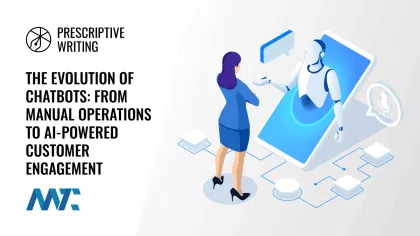
Chatbots have significantly transformed in recent years, evolving from manual, human-operated systems to sophisticated AI-powered tools, reshaping customer engagement strategies. This article explores the advancements in chatbot technology, their impact on business operations, and how to implement them effectively.
The AI Revolution in Chatbot Technology
The initial wave of chatbot implementations was often costly in terms of manpower and resources. Early chatbots required extensive manual programming and constant human oversight. They relied heavily on predefined scripts and decision trees, which limited their flexibility and effectiveness. These systems often struggled with understanding context, nuance, or complex queries, necessitating frequent human intervention.
Companies investing in chatbots allocated significant resources to develop, maintain, and monitor these systems. Teams of developers were needed to program responses for various scenarios, while customer service representatives had to stand by to take over conversations when chatbots failed to provide adequate assistance. This approach was expensive and time-consuming and often resulted in subpar user experiences (UX).
Moreover, early chatbots could not learn from interactions, so improvements and updates had to be manually implemented. This resulted in a continuous cycle of tweaking and refining, further adding to the resource burden.
In contrast, modern AI-powered chatbots have dramatically reduced these costs and resource requirements. They utilize machine learning and natural language processing to more accurately understand and respond to user queries. These advanced systems can:
- Learn and improve from each interaction, reducing the need for constant manual updates.
- Handle a wider range of queries without human intervention.
- Understand context and intent, providing more relevant and helpful responses.
- Integrate with existing knowledge bases and systems, reducing the need for manual data input.
- Scale more easily to handle increased volumes of interactions without a proportional increase in costs.
This evolution has transformed chatbots from resource-intensive tools to cost-effective solutions that significantly enhance customer service while reducing operational expenses. Today’s chatbots offer a much higher return on investment (ROI), making them an attractive option for businesses of all sizes. Key feature advancements include:
- Automation and Routing: AI-powered chatbots can handle multiple conversations simultaneously and intelligently route complex queries to appropriate departments.
- Helpdesk Automation: AI chatbots can resolve common issues without human intervention, significantly reducing the workload on support teams.
- Hybrid Human-AI Interaction: Modern chatbots combine AI capabilities with human oversight, allowing for seamless escalation to human agents when necessary.
- Sentiment Analysis: Advanced natural language processing (NLP) enables chatbots to understand and respond to customer emotions, improving the overall quality of interactions.
- Knowledge Base Integration: Chatbots can now access and utilize vast knowledge bases (KB) to provide accurate and contextual information.
- Virtual Buying Assistance: Chatbots can guide customers through the purchasing process, offering product recommendations and answering questions in real-time.
Key Chatbot Platforms
Several platforms have emerged as leaders in the chatbot space:
- Dialogflow (Google): Offers advanced NLP capabilities and integrates seamlessly with Google’s ecosystem.
- IBM Watson Assistant: Provides robust AI and machine learning (ML) capabilities for enterprise-level chatbot solutions.
- Microsoft Bot Framework: Offers a comprehensive set of tools for building and deploying chatbots across multiple channels.
- Salesforce Einstein Bots: Integrates deeply with Salesforce CRM, offering powerful customer service automation.
- Intercom: Combines live chat, chatbots, and a customer data platform for a comprehensive customer communication solution.
- ManyChat: Focuses on easy-to-use chatbot creation for marketing and e-commerce on platforms like Facebook Messenger.
Implementing a Successful Chatbot Strategy
To ensure your audience welcomes your chatbot, follow these steps:
- Define Clear Objectives: Identify specific goals for your chatbot, such as improving customer service response times or increasing sales conversions.
- Understand Your Audience: Research your customers’ preferences and pain points to tailor the chatbot experience accordingly.
- Choose the Right Platform: Select a chatbot platform that aligns with your technical capabilities and business needs.
- Design Conversational Flows: Map out possible conversation paths and ensure the chatbot can handle various scenarios.
- Integrate with Existing Systems: Connect your chatbot with your CRM, knowledge base, and other relevant systems for a seamless experience.
- Train Your AI: Provide your chatbot with quality data to improve its understanding and responses over time.
- Implement Human Escalation: Define clear triggers for when a conversation should be handed off to a human agent.
- Test Thoroughly: Conduct extensive testing to identify and fix any issues before launch.
- Launch and Monitor: Start with a soft launch and closely monitor performance metrics and user feedback.
- Continuous Improvement: Regularly analyze chatbot interactions and user feedback to refine and improve the system.
Chatbots have come a long way from their humble beginnings. Today’s AI-powered chatbots offer businesses a powerful tool for enhancing customer engagement, streamlining operations, and driving ROI. By following a strategic implementation approach and leveraging the right technology, companies can create chatbot experiences that are not only welcomed by their audience but become an integral part of their customer service and marketing strategies.